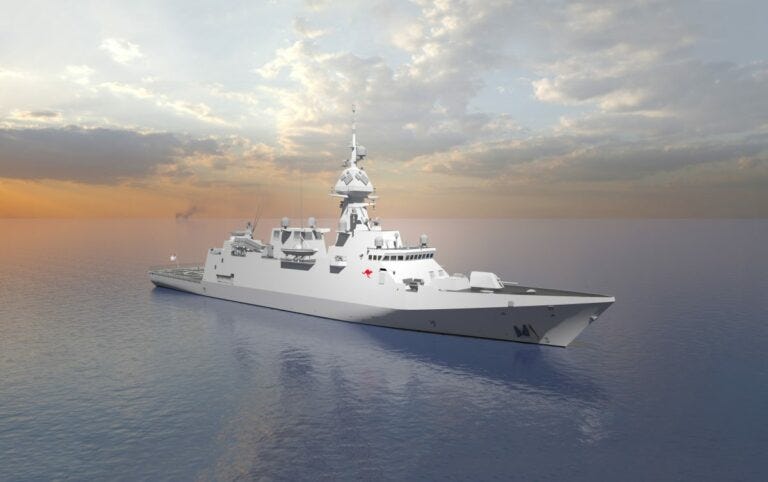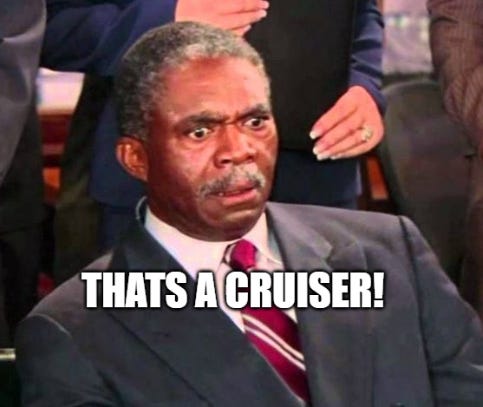What a Balanced Fleet Looks Like
Navantia's Right Answer for Australia
Ever feel happy, sad, and a bit enraged at the same time?
Well, of course you do … you read CDR Salamander!
OK, we’re not that bad…every day…but - today is one of those days.
So much of our time here through the decades has been raging against the almost criminal fleet design, program management, and execution of what used to be the world’s largest Navy. We’re still the best, in aggregate due to the capability and size combination, but that rings more and more as a cope than anything else.
You know the basket of deplorables; LCS, DDG-1000, CG(X) and until more time, money, and Sailor sweat made they acceptable - to a lesser extent LPD-17 and FORD.
There is your “enraged” flavor.
How about the “happy?” Well, Navantia has some proposals for the Royal Australian Navy that, well, looks like it was proposed by ‘ole Sal.
You know me - I want a balanced fleet of multi-purpose warships that provide the best flexibility for our Navy to fight and win not just against what we think will meet us at sea - but especially for those things we don’t think of.
We can’t have all big ships, nor all small ships … but we do need more ships and ships that can conduct independent steaming and can more than protect themselves and others should things get unexpectedly spicy.
Australia wants a more modern - and if possible - numerous fleet. Smart … and via Alex Luck Naval News, look at what Navantia is rolling out;
Tasman-class corvette.
The Tasman-class corvette is a combatant measuring 109.6 metres in length, 15.35 metres beam and a displacement up to 3,600 tons depending on exact configuration. According to Navantia it is an Australianised version of the Alpha 3000-design built for Saudi-Arabia as the Avante-class, and as such promoted as a proven design. As armament and defensive equipment suite the ship features 16 configurable VLS-cells, four quadruple antiship-missile-launchers in slanted racks, a main gun in the 57 mm-category, two triple torpedo launchers, a lighter 30 mm or less Close In Weapon System (CIWS), two remote weapon stations (RWS) accommodating heavy machine guns, and dual decoy launchers. The corvette carries a version of CEA’s CEAFAR phased array radar and SEAMOUNT missile illuminator system. Finally the ship offers two RHIBs and features a hangar and helipad for a Seahawk-class helicopter, in addition to a mission bay below the landing pad accommodation RHIBs or USVs.
Alpha 5000 Combatant
The larger Alpha 5000 Combatant is a frigate-sized concept coming in at 4,550 tons displacement., a length of 121 metres and beam of 16 metres. It distinguishes itself from the Tasman-class corvette by featuring an additional 16 VLS-cells amidships for a total count of 32 cells, reducing the antiship-missile count to 8 instead. Alpha 5000 also maintains the CIWS and torpedo launchers, but features a larger main gun of 76 mm calibre, and a more capable configuration of CEAFAR. Similar to the Tasman-class the frigate-design also includes a mission bay below the helicopter pad. Alpha 5000 can accommodate flexible mission-configurations including for ASW and mine-warfare, but also considering humanitarian roles.
Flight III Destroyer
The final proposal is aimed at the RAN-requirement for a large displacement combatant with deep magazine capacity, covering air warfare and strike-requirements dubbed “Flight III Destroyer”. The name is a reference to evolving the original Hobart-class design and following a separate design dubbed “Flight II”, effectively an Australianised F110 as built for the Spanish Navy, this concept proposes an effectively cruiser-sized vessel of 10,200 tons displacement at 165 metres length and a beam of 21 metres. Primary armament includes 128 VLS cells in two 64 cell-segments on the bow and amidships. As such it is a fully new design despite the “Flight”-reference. The ship also features a 127 mm-main gun and two gun-based CIWS of the Phalanx-type. Aside from the substantial missile armament a notable feature is a propulsion of the CODAG (combined diesel and gas turbine) electric-variety also supporting future integration of directed energy weapons. CEAFAR is featured again as radar suite.
Distinct characteristics are “drone swarm” and “anti drone swarm”-launchers port and starboard of the helicopter landing pad complementing a “UUV zone” below the helo pad. Flight deck and hangar support a Seahawk-class helicopter similar to the other two Navantia-proposals.
A decision by the Australian government following the recommendations of the Surface Combatant Review regarding the future force mix for RAN will be revealed in 2024.
Two of the three are evolved from existing platforms, and I am sure the third has a lot of repurposed design components.
Nothing “transformational,” “exquisite,” or for that matter - something carefully constructed around someone’s fetishized vignette and not much else.
For comparison, let’s look at what the USN”s fleet will have running around at the end of the decade in this same surface force area. This highly abbreviated graphic should do;
The first think that pops out to me is that the “Flight III Destroyer” looks to be what CG(X) - if ‘ole Sal was running requirements - would have broadly looked like and would already be deployed.
Sorry mate, but…
Wish it had two 127mm main guns that the civilized world would call 5-inch … but you can’t have everything.
Given the geography of Australia, I think the “corvette, frigate, cruiser” is … shockingly … spot on.
Honestly, we could use something along the lines of the Tasman or Alpha 5000 too, but that isn’t in the cards. That’s where I get a bit sad. Mixed in with some envy, but “sad.”
Second thing that pops out, is this shows clearly that the Constellation Class are “heavy frigates” but frigates nonetheless.
Third? I really hope the SM6 ASUW capability is REAL good.
It will be interesting to see how this plays out, but for an opening hand, this looks like a winner.





I was looking through my father's 1946, Blue Jackets Manual and came across this passage on page 184.
Purpose of naval forces:
"Our Navy is a fighting organization designed to engage and defeat our enemies on, over, and under all the oceans of the world."
1. The Navy protects the over-water transportation of our own and friendly land forces, air forces, supply and trade.
2. The Navy prevents the enrmy from using the sea to transport his land forces, air forces,msupplies and trade.
Page 187 to 189
Characteristics of fighting ships:
1. Armament
2. Armor protection
3. Speed
4. Maneuverability
5. Range (they stress "sea keeping" ability as an important characteristic in the Pacific Ocean)
6. Expandability (they acknowledge that ships will be sunk)
While technology has changed, basic characteristics that are found in any "warship" haven't fundamentally changed. Just the opinion of an old hermit.
(Page 193: "Cruisers range in displacement from 5,000 to 15,000 ton.") Calling the Zumwalt class a "destroyer" is silly.
We could DEFINITELY use several squadrons of Tasmans. Western Hemisphere work, Pacific Island chains, Africa, the Mediterranean.....